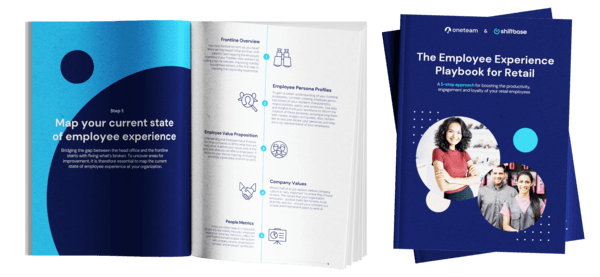That it is important to invest in your employees is common knowledge. But what does it deliver? It improves business results, creates a nice company culture and is focused on your employees' needs.
Retain your employees with the ultimate employee experience!
Employee experience has become a quick and powerful tool for companies looking to influence employee engagement and effectiveness. As a result, you retain your employees and create ambassadors for your organisation. This makes recruiting new employees easier!
With this E-book, we help you in 5 steps to improve and manage the employee experience within your organisation. You will discover:
- Why employee experience is so important
- What employee experience means
- The current status of your employee experience
- Which important role WFM management plays in your employees' experience
- Which tools you can best use to improving employee experience

What is employee experience?
The employee experience encapsulates everything an employee encounters, observes or feels throughout their journey within an organization. It's an umbrella term that includes the work environment, corporate culture, and the technological tools at an employee's disposal.
As businesses increasingly acknowledge the value of their people as the most significant resource, providing an enriching and engaging employee experience has never been more crucial.
The current state of employee experience in different industries
While some industries have made significant strides in enhancing the employee experience, others lag. Tech industries, for instance, often lead the pack, offering flexible work arrangements, innovative workspaces, and engaging company cultures.
On the other hand, more traditional industries like manufacturing and retail often struggle with rigid hierarchies, monotonous work environments, and limited scope for growth and innovation.
Common shortcomings and challenges
-
Lack of feedback channels: Many organizations don't provide efficient means for employees to express their thoughts or concerns, leading to frustration and feeling undervalued.
-
Inadequate career development opportunities: When companies don't offer opportunities for learning and growth, employees can feel stagnant and unfulfilled.
-
Poor work-life balance: In high-pressure industries, employees often struggle to maintain a healthy work-life balance, resulting in burnout and decreased productivity.
The impact of a negative employee experience on businesses

-
Decreased productivity: Employees who feel undervalued or overstressed tend to be less engaged, leading to decreased productivity and potentially impacting a company's bottom line.
-
High employee turnover: Negative experiences often prompt employees to seek other opportunities, resulting in high turnover rates and associated recruitment and training costs.
-
Damaged reputation: In the age of social media and employer review sites, negative employee experiences can harm a company's reputation, making it harder to attract top talent.
The power of employee experience
While the challenges are significant, the power and potential of a positive employee experience are far greater. Below, we explore some of the benefits to employers and employees.
Benefits to employers
-
Increased productivity: Happy employees are more engaged and productive. They're more likely to go the extra mile, directly benefiting business operations.
-
Employee retention: Employees with positive work experiences are less likely to leave. This reduces costs related to turnover and recruitment.
-
Improved customer service: Happy employees often lead to happy customers, as engaged and satisfied employees are likelier to deliver top-tier customer service.
Benefits to employees
-
Higher job satisfaction: Positive employee experiences often result in higher job satisfaction, enhancing employees' overall quality of life.
-
Career growth: Companies prioritizing employee experience often provide robust growth and learning opportunities, enabling employees to progress.
-
Greater work-life balance: Companies that value employee experience tend to offer more flexibility, contributing to a healthier work-life balance for employees.
The journey of enhancing the employee experience is a transformational one. As businesses strive to create positive, engaging environments for their teams, they unlock a wealth of potential for growth, innovation, and success.
Key components of an enhanced employee experience

Creating an enhanced employee experience involves a careful balance of various components. When these elements work in harmony, they pave the way for an environment that fosters innovation, productivity, and overall job satisfaction.
Physical environment
The physical workspace plays a vital role in shaping the employee experience. It goes beyond having a comfortable chair or a desk; it's about creating a space where employees feel relaxed, motivated, and inspired.
- Natural lighting
- Open spaces
- Ergonomic furniture
- Areas for relaxation and collaboration
These things can significantly impact an employee's mood, creativity, and productivity. More companies are recognizing this and are redesigning their workplaces to be more worker-friendly, with amenities that enhance comfort and promote employee well-being.
Technology
In the digital age, employees' daily technology greatly influences their experience. Outdated, cumbersome systems can lead to frustration, inefficiencies, and disengagement.
On the other hand, modern tools and platforms that streamline work processes can improve collaboration and productivity, positively impacting the overall employee experience. This can include project management software, communication tools, and even AI-driven platforms that automate routine tasks, freeing employees to focus on more complex and satisfying work.
Culture
Company culture significantly impacts the employee experience. A positive culture, characterized by transparent communication, inclusivity, shared values, and mutual respect, contributes to an environment where employees feel valued and motivated.
On the contrary, a toxic culture can result in high stress, low morale, and high turnover. The significance of company values and their impact on the employee experience cannot be overstated. Values act as the company's compass, guiding behavior, decision-making, and interactions within the workplace.
Growth opportunities
Opportunities for professional development and career advancement are critical components of the employee experience. Employees are more likely to feel engaged and committed to an organization that invests in their growth and sees them as more than just a number. This can include:
- On-the-job training
- Mentoring programs
- Continuing education
- Clear career progression paths
When employees see a future within the organization and feel that their personal growth is valued, their job satisfaction and productivity often increase, which can greatly benefit the business in the long run.
Strategies for enhancing the employee experience

Enhancing the employee experience requires thoughtful, deliberate action. Below, we delve into several strategies that can help businesses provide an enriching and engaging employee experience.
Leadership's role in fostering a positive employee experience
Leadership sets the tone for the entire organization. Leaders who actively foster a positive employee experience tend to have more engaged, productive teams. Here are three techniques to do so:
-
Lead by example: Leaders can demonstrate the behavior and attitude they wish to see in their employees. This includes showing empathy, promoting transparency, and embodying the company's values.
-
Open communication: Leaders should encourage open dialogue, actively listen to their team's concerns, and provide constructive feedback.
-
Empowerment: By giving employees autonomy and trusting them to make decisions, leaders can foster a sense of ownership and engagement.
Implementation of employee feedback mechanisms
Feedback is critical in enhancing the employee experience. It provides insights into areas of improvement and can help address issues before they escalate. Three techniques to implement this strategy include:
-
Regular surveys: Regular employee satisfaction surveys can provide valuable data on different aspects of the employee experience.
-
Feedback sessions: Regular one-on-one or team feedback sessions can help address specific concerns and encourage dialogue.
-
Anonymous channels: Provide anonymous channels for feedback to ensure employees feel safe sharing their honest thoughts and concerns.
Introduction of flexible work policies
Flexible work policies can significantly improve the employee experience by promoting a healthy work-life balance. Here's how to introduce them:
-
Remote work Options: Allowing employees to work from home, part-time or full-time, provides flexibility and increases job satisfaction.
-
Flexible hours: Instead of adhering to strict work hours, companies can allow employees to adjust their schedules to fit their personal lives better.
-
Job sharing: This allows two people to share the responsibilities of one full-time position, providing more flexibility.
Importance of recognition and rewards
Recognizing and rewarding employees for their hard work and achievements can boost morale and motivation. Here are three ways to do it:
-
Regular employee appreciation: Simple acts of recognition, such as a thank you note or a mention in a team meeting, can go a long way in making employees feel appreciated.
-
An employee of the month: Regularly highlighting an employee's achievements can boost motivation and showcase the behaviors that the organization values.
-
Performance bonuses: Financial rewards tied to performance can incentivize employees to work towards their goals.
By adopting these strategies, businesses can significantly enhance their employee experience, leading to higher engagement, productivity, and retention rates. After all, a positive employee experience doesn't just benefit the employees - it contributes to the business's overall success.
Useful Read: 6 Metrics to Measure Employee Engagement: The Employers Guide
The four phases of employee experience

The journey of an employee in an organization typically follows four distinct phases. Understanding these phases can provide valuable insights to enhance the overall employee experience. Here they are:
1. Attraction
The attraction phase begins even before a candidate applies for a job. It's about how potential employees perceive the organization from the outside. Everything from the company's reputation, and brand image, to job postings and the organization's online presence contributes to the attraction phase.
To enhance the experience during this phase, companies should focus on presenting an authentic and engaging employer brand. Clear, appealing job descriptions, an easy application process, and active social media engagement are crucial in attracting top talent.
2. Recruitment and onboarding
The recruitment and onboarding phase begins once a candidate applies and is selected for a role. This phase sets the tone for the employee journey within the organization. It includes everything from the interview process to orientation and initial training.
A streamlined, respectful, and efficient hiring process is key to a positive experience. An effective onboarding program also helps new hires feel welcomed and prepared, setting them up for success from the start.
Useful Read: How To Use AI In Recruitment: A Guide for HR Pro's
3. Development and retention
Once the employee is successfully integrated into the organization, the focus shifts to their development and retention. This phase is about ensuring the employee feels engaged, valued and sees a clear path for growth within the organization.
Organizations should provide regular feedback, learning opportunities, and a supportive work environment to enhance this phase. Recognition of efforts and achievements and provisions for work-life balance also play significant roles in this phase.
4. Departure
Eventually, employees will leave the organization, marking the departure phase. This could be due to retirement, a new job, or other reasons. This phase aims to ensure a smooth transition that respects and values the departing employee's contributions.
Exit interviews can provide valuable insights to improve the employee experience moving forward. Additionally, maintaining positive relationships with alums can open doors for potential re-hires and referrals in the future.
Steps toward building great employee experiences
Building great employee experiences is a journey, not a destination. It's a continuous process that requires strategic planning, thoughtful execution, and regular review. Below are some steps to guide you through this transformative journey.
1. Gain an overview
Before enhancing the employee experience, you need to understand the current situation. This requires an in-depth look at your organization's current practices, policies, and culture. Consider these:
- Conduct employee experience surveys to gauge their level of satisfaction, engagement, and areas they believe need improvement.
- Observe the physical workspace and the tools employees use. Are they conducive to productivity and satisfaction?
- Evaluate the company culture. Are company values lived out or just words on a page?
By understanding the status quo, you're better equipped to plan improvements effectively.
2. Define goals
Once you've gained an overview, the next step is to define clear, actionable goals. What do you want to achieve by enhancing the employee experience? Goals could include:
- Increasing employee engagement and productivity.
- Reducing employee turnover.
- Attracting top-tier talent.
- Improving customer satisfaction through better service delivery by happy employees.
Remember, your goals should align with your organization's broader objectives. They should be specific, measurable, achievable, relevant, and time-bound (SMART).
3. Develop a strategy
After defining your goals, it's time to develop a strategy. This involves a series of actions:
- Prioritize areas that need improvement based on the feedback from the overview phase.
- Determine the resources required to effect changes. This might involve investing in better technology, redesigning workspaces, or hiring additional HR staff to manage initiatives.
- Plan to implement feedback mechanisms, employee recognition programs, and career development opportunities.
4. Implement changes
With your strategy in hand, it's time to execute the changes. Ensure that the process is transparent and involves all relevant stakeholders. A top-down approach, with leaders spearheading the changes, can help secure organizational buy-in. Remember, communication is vital during this stage.
5. Monitor and review
Finally, it's important to monitor progress and review the effectiveness of the changes. Use the goals you set as benchmarks and assess performance against them. Regular reviews can help you identify areas of success and those that need further adjustment.
Building great employee experiences is an ongoing process, but following these steps can create a workplace where employees thrive, leading to tangible benefits for your organization.
Overcoming challenges in transforming the employee experience

Transforming the employee experience strategy can bring its set of challenges. Below are some common obstacles and strategies to overcome them.
Resistance to change and strategies to mitigate it
Change, though often necessary, can create discomfort and uncertainty. This can lead to employee resistance, posing a significant challenge to transformation efforts. Here's how to mitigate it:
-
Involve Employees: Include employees in the transformation process from the start. Their input can provide valuable insights and foster a sense of ownership, reducing resistance.
-
Clear Communication: Communicate the reasons for the change, its benefits, and the implementation plan. Understanding the 'why' behind the change can help employees embrace it.
-
Provide Support: Offer support throughout the change process. This could involve training, resources, or an open-door policy where employees can voice their concerns.
Investing in the right resources
The employee experience transformation often requires an investment in resources, be it time, money, or technology. Here's how to navigate this challenge:
-
Prioritize: Identify the areas of the employees experience that need the most improvement and prioritize investment in these areas.
-
Budgeting: Allocate a specific budget towards enhancing the employee experience. Remember, a happier, more engaged workforce can increase productivity and lower turnover, making it a worthwhile investment.
-
Smart tech choices: Invest in technology that directly improves the employee experience. This could be project management tools, communication platforms, or HR software.
Importance of consistent communication and transparency
Maintaining consistent communication and transparency can be challenging, but it's crucial in transforming the employee experience. Here's how to achieve it:
-
Regular updates: Regularly update employees about changes in the company, upcoming events, and overall company health. This keeps employees informed and reduces uncertainty.
-
Open dialogue: Encourage open dialogue. Let employees know that their opinions are valued, and their voices are heard.
-
Transparency in decision-making: Be transparent about the company's decision-making processes. When employees understand how and why decisions are made, it fosters trust and reduces frustration.
Overcoming these challenges is not an easy task. Still, with the right strategies, businesses can successfully transform their employee experience, creating a more engaged and productive workforce and driving business growth.
Measuring the impact of enhanced employee experience
Measuring their impact is crucial once you've implemented strategies to enhance the employee experience. Understanding the effectiveness of these strategies can inform future decision-making and highlight areas for further improvement.
Key metrics to measure employee experience
Several key metrics can provide valuable insights into the employee experience:
-
Employee engagement reflects the employee's emotional commitment and enthusiasm towards their work and the company. Higher engagement often leads to higher productivity.
-
Employee satisfaction: Regularly conducted satisfaction surveys can help you gauge how happy your employees are with their roles, colleagues, managers, and the company as a whole.
-
Turnover rate: A high turnover rate can signal dissatisfaction among employees. Conversely, a low turnover rate may indicate a positive employee experience.
-
Absenteeism: Frequent absences can signify disengagement and dissatisfaction, while lower absenteeism rates may indicate a positive work environment.
Use of employee experience data to drive strategic decisions

Employee experience data is a valuable resource for driving strategic decisions:
-
Identifying areas for improvement: Employee feedback can highlight areas that need improvement, informing where resources should be allocated.
-
Talent Retention: Data on turnover rates and exit interviews can provide insights into why employees leave, allowing strategies to be implemented to improve retention.
-
Recruitment Strategy: Understanding what employees value can help shape recruitment strategies to attract the right talent.
Long-term benefits of investing in employee experience
Investing in the employee experience has several long-term benefits:
-
Improved productivity: Happier, more engaged employees are often more productive, driving business performance.
-
Talent attraction and retention: A positive employee experience can help attract top talent and decrease turnover, reducing the costs of hiring and training new staff.
-
Enhanced customer experience: Employees satisfied and engaged at work can provide superior customer service, improving the customer experience and potentially leading to higher customer retention and acquisition.








